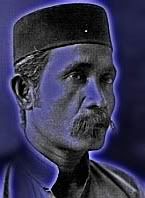Music in the Isle
Time flies, water flows, the sun sets and the moon rises. But the music goes on.
This is an old picture, again from the family album of my friend Chorekdaggarik who also sent us that delightful picture of women cycling in Chendering that I blogged about in Les Bicyclettes de Chendering.
This photograph was taken in February 1956, on an island just off Pulau Duyung. It touches me in many ways, not least because one of the persons in this photograph, the man fiddling on the left, is Wan Muhammad Dato' Perba, the photographer who set up his photo studio above Pök's shop [see, Snaps and Studios, GUiT, p.50; "Nails, Ropes and Old Vinegar", p. 33], just a stone's throw from our house. I never threw stones at Pök's, I promise you, but we went there for odds and sods - nails, fishing hooks, bits of string and sometimes just for a chat. Pök was a genial man whose shop reeked of vinegar that he kept in clay pots in the back. He once sold my brother a hook and line and told him to go to the Sekölöh Paya Bunga (Paya Bunga School) for the rod. The school then had a hedge of thin bamboos.
We have many photographs in our family album taken at Wan Mohammad's photo studio with its cardboard Greek columns and the full moon backdrop.
The photograph also touches me in another way. In the back of the photo is this inscription:
It says, "Berkelah di Pulau Belakang Pulau Duyung pada 3/2/56 sekelian famili Dato' Perba dan Encik Omar, bèsangnya. Ahli-ahli muzik sahaja."
"Picnic on the island behind Pulau Duyung on 3/2/56, the entire family of Datuk Perba and Encik Omar, his bèsang. Musicians only."
Bèsang is the Trengganuspeak rendition of bèsan, a relationship that has no equivalent in English. He or she is the person whose child is married to one of yours.
Early mornings I used to look out from the windows of the front of our Tanjong house, to the activities in the market. Below us was a shop, run by a man named Haji Nik (we called him Ayöh Nik) and a very amusing and witty man we called Che Awang who could draw and tell jokes and do conjuring tricks. Che Awang was from the family of Dato' Amar (the Man of Oob in GUiT) and Ayöh Nik was one of the children of Encik Omar, but I doubt if he is in the photograph as he was a no-nonsense man not given to much music.
Thank you Chorekdaggarik for sharing with us this wonderful photograph.
Read Also:
Chainlink to Pok's Family
Labels: Ayöh Nik, Che Awang, Family of Dato' Perba, Haji Nik Omar, Pök, Pulau Duyung, Wan Mohamed bin Dato' Perba










